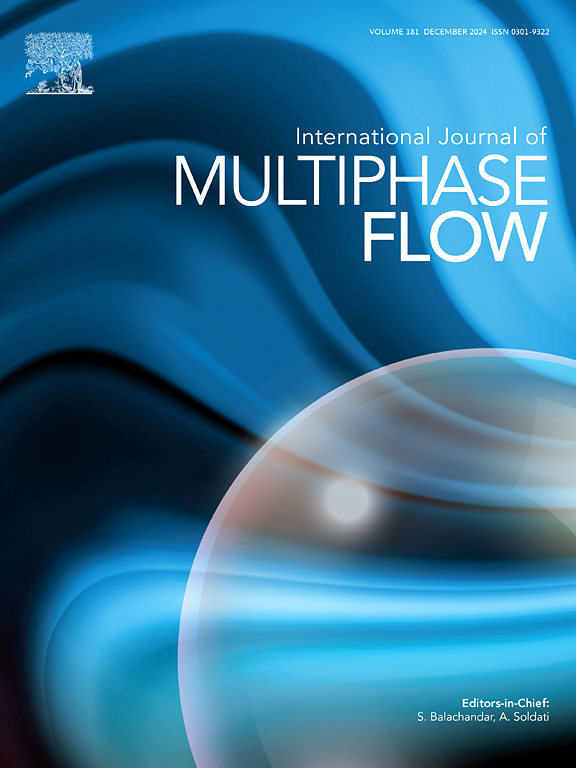基于梯度的测量,以了解热管理应用中二氯甲烷的沸腾特性
IF 3.8
2区 工程技术
Q1 MECHANICS
International Journal of Multiphase Flow
Pub Date : 2025-04-12
DOI:10.1016/j.ijmultiphaseflow.2025.105258
引用次数: 0
摘要
本研究探讨了高挥发性流体之一的二氯甲烷(DCM)在饱和核沸腾过程中单个蒸汽泡的动力学特征。沸腾实验在常压下的四种热通量条件(25、35、50 和 65 kW/m²)下进行。薄膜干涉仪和高速彩虹离散偏转仪被串联使用,以同时捕捉微层和/或干斑和蒸汽气泡的动态。对 DCM 气泡等效直径的时间演变进行的详细分析揭示了不同的阶段:惯性控制的增长、过渡体制和扩散控制的膨胀。此外,还研究了各种力(如浮力、接触压力、表面张力和增长力)在胀泡周期中的时间演变。与传统的力平衡分析不同,该方法使用时空分辨的全场实验数据来划分从气泡萌发到离开时间(td)期间所涉及的力。值得注意的是,与水等传统工作流体相比,DCM 显示出一种独特的气泡形成机制,尽管它与铟锡氧化物涂层玻璃具有很高的润湿性,但却没有任何微层。随着热通量的增加,气泡离开的频率也相应地线性增加,而生长时间却没有显著增加。对高挥发性流体气泡胀破周期进行的力平衡分析表明,在 0.8td 之前,普遍存在的向下力会促进气泡生长,同时抑制气泡离开。然而,超过 0.8td,向上的力就会占上风,抵消向下的力,使气泡离开成核表面。本文章由计算机程序翻译,如有差异,请以英文原文为准。

Gradients-based measurements to understand the boiling characteristics of dichloromethane for thermal management applications
The present work investigates the dynamical characteristics of single vapor bubble during saturated nucleate boiling of dichloromethane (DCM), one of the high volatile fluids. Boiling experiments have been performed for four heat flux conditions (25, 35, 50, and 65 kW/m²) under atmospheric pressure. Thin-film interferometry and high-speed rainbow schlieren deflectometry were employed in tandem to simultaneously capture the dynamics of microlayer and/or dry-patch and vapor bubbles. A detailed analysis of the temporal evolution of the equivalent diameter of DCM bubbles reveals distinct phases: inertia-controlled growth, a transitional regime, and diffusion-controlled expansion. Furthermore, the temporal evolution of various forces, such as buoyancy, contact pressure, surface tension, and growth forces are examined during the ebullition cycle. Unlike traditional force balance analyses, the spatio-temporally resolved whole-field experimental data is used for delineating the forces involved from bubble inception to departure time (td). Notably, in contrast to the conventional working fluids, for instance water, DCM displays a distinct bubble formation mechanism that is devoid of any microlayer, despite its high wettability with indium-tin-oxide coated glass. As the heat flux increases, there is a corresponding linear increase in bubble departure frequency, with no significant rise in growth time. The force balance analysis during the ebullition cycle of the vapor bubble of the considered high volatile fluid reveals that until 0.8td, the prevailing downward force promotes bubble growth while inhibiting departure. However, beyond 0.8td, the upward force takes precedence, counteracting the downward force and enables the bubble's departure from the nucleating surface.
求助全文
通过发布文献求助,成功后即可免费获取论文全文。
去求助
来源期刊
CiteScore
7.30
自引率
10.50%
发文量
244
审稿时长
4 months
期刊介绍:
The International Journal of Multiphase Flow publishes analytical, numerical and experimental articles of lasting interest. The scope of the journal includes all aspects of mass, momentum and energy exchange phenomena among different phases such as occur in disperse flows, gas–liquid and liquid–liquid flows, flows in porous media, boiling, granular flows and others.
The journal publishes full papers, brief communications and conference announcements.

 求助内容:
求助内容: 应助结果提醒方式:
应助结果提醒方式:


